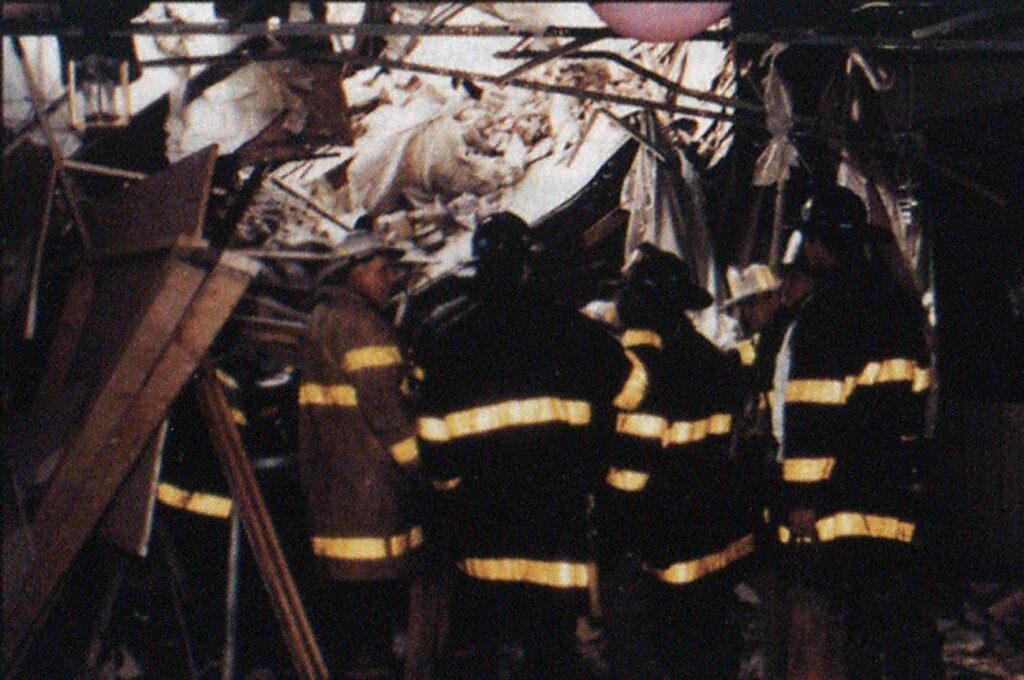
RESCUE POINTS TO PONDER
The rescue operations in these photographs offer a number of points to ponder. We’ll give you a few, in no particular order of importance. Write to us with your own operational considerations of the scenarios depicted, and we’ll publish them in a future issue.

- It is possible that live victims still are trapped. How many and where?
- How stable is the remaining structure?
- Look for cracks in the walls and around windows, signs of sagging, damaged or out-of-plumb columns.
- Make sure the utilities have been shut down— i.e., gas, electric, water.

(Photo by Tony Greco.)
- What is the condition of the driver of the small truck? Does he need immediate treatment? The seriousness of his injuries will dictate speed and method of victim removal.
- What is the safest means of separating the small truck from the trailer? Jack up the trailer? Flatten the tires of the small truck to get it out from under the trailer?
- Remember the dangers of vehicle fuels. Be sure to use nonsparking tools and equipment around leaking flammable liquids.

left by Ken Murray: photo at right by Steven Spak.)

- What is the number of passengers involved, how many survivors? Total accountability is essential. Rescuers must obtain the flight manifest. Communication with airport and airline personnel is key.
- Are survivors still in the water? Where? The bay was a large area of water to search.
- How and where to remove victims—to EMS staging area, to temporary morgue, or directly to hospital?

(Photo by Jack Jordan.)
- What are oxygen levels in the hole? Any chemicals, toxins, or other hazards? Air monitoring is important.
- What is the victim’s physical and mental condition? Can he communicate with rescuers?
- Is the rescuer equipped with safety lines, communication and other necessary equipment for safe victim removal?

- Utilize safety lines for victim removal to apparatus.
- Apparatus can be used as a point of refuge: victims can climb on top to escape flooding waters.
- Search for other possible stranded or trapped victims—look for other cars, with people either in or on top of them.

(Photo by Bob Pressler.)
- Number of victims in, under, or around car? Passengers may be thrown clear of wreck. If survivors can communicate, ask them.
- Is the vehicle completely stabilized? Again, chocks and blocks.
- How and from where can rescuers gain access? If the victim is upside down, would you cut through the floor of the car?

(Photo by Kevin Todd.)
- Provide a safe working zone. Keep onlookers, victims, and uninvolved personnel away from the working area for their protection.
- Make sure the victim is protected from breaking glass and tools (cover with blanket) and stabilized during rescue operations.
- Are sufficient resources at the scene? Be proactive, not reactive. Don’t waste time calling for additional personnel and equipment. Bring enough with you initially.

(Photo by Larry Collins.)
- Stabilize window-washing scaffolding. Lower ropes to tie it off so it won’t slip.
- Tie a safety line to the victim when you first reach him in case scaffolding drops.
- Are there sufficient rescue rope and equipment for lowering the victim to street level or other floor where he safely can be hauled in?

(Photo by Tom Denton.)
- The walls of the trench must be properly shored.
- Means of egress and access must be provided—two ladders, one at either end, are recommended in case of secondary cave-in.
- Are the hazards in the trench—water, electric, or gas lines—being addressed?

(Photo by Owen Jacobs.)
- Stabilize the shaft opening to guard against sides caving in.
- What is the status of the working space within the opening—width—which will affect the number of rescuers that can safely work in the shaft?
- Utilize resources at the scene—cranes, hoisting devices, and so on.

(Photo by Bob Pressler.)
- Is the aircraft stable? Consider chocks, blocks, cribbing, and tying off the aircraft.
- Number of possible passengers?
- Accountability—identify aircraft, where it came from, where flight plan is filed.
- Precautionary handlines are stretched. Is foam needed?

- The victim must be properly and safely secured for removal.
- Make sure ground pads are in place to stabilize area around hole so rescuers don t push dirt in on victim.
- Backup rescue team should be standing by in case the first team becomes trapped.


